
Evergreen boughs. Poinsettias. Holiday cacti. These are the indoor plants of the holiday season. Of all these, the holiday cactus (plural is cacti) can be the longest-lived, giving a greater bounty of flowers with each successive year. Some people do indeed have a green thumb in getting holiday cacti to grow and thrive but all too many of these plants, that are either received as gifts or purchased for their cheerful seasonal color, languish and eventually die. This article is intended to help you not only keep your holiday cactus alive, but even more, to successfully achieve that desired floral spectacle year after year.
With brightly colored flowers in shades of pink to red, white and bicolors, blooming holiday cactus plants are a welcome sight at this time of year, but not all types bloom in late December. Many specimens have been kept as houseplants for years, or even decades.
What is a Holiday Cactus?
Holiday cacti are indeed true cacti, in the same plant family as the giant saguaros of Arizona and our native Wisconsin prickly pears. The origins of holiday cacti are found in the mountainous jungles of Brazil, where they grow as epiphytic plants, with their roots anchoring them to branches high up in forest trees or sometimes growing in shady areas of cliffs or rock outcrops. Because of their rounded and flattened appearance, the stems are often confused for leaves but, like most cactus, there are no true leaves. In nature, the plants are pendant, hanging from their perches on trees or cliffs. Although young plants have an upright form, as they age the ends of the branches tend to sag, giving a very graceful appearance. In age, the basal stems get thickened and woody, helping support the weight of the younger stems and, seasonally, the great profusion of flowers.
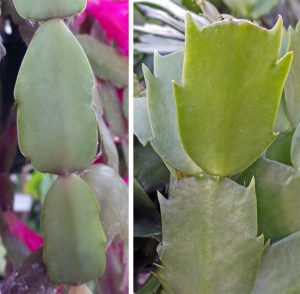
In nature there are relatively few types, or species, of holiday cacti and they belong to two different genera, Rhipsalidopsis and Schlumbergera. Rhipsalidopsis are spring bloomers and are sometimes referred to as Easter cactus. But in this article we will discuss Schlumbergera because these are the plants that commonly bloom from early November into January, during the holidays of Thanksgiving, Christmas, and New Year. A plant in this genus would commonly be called Christmas cactus and, occasionally, Thanksgiving cactus.
There are relatively few natural species of Schlumbergera and the vast array of colors in the many cultivars and hybrids on the market today result primarily from the parentage of a true species, S. truncata and an early hybrid known as S. x buckleyi. S. truncata (formerly known as Zygocactus truncatus) has distinctly pointed projections at the edges and ends of the stem segments, whereas S. x buckleyi has more rounded, scalloped edges. S. truncata blooms earlier, closer to Thanksgiving, while S. x buckleyi blooms closer to Christmas. Hybrids between the two have intermediate blooming times.
In nature, Schlumbergera flowers range from pale to deep pink and occasionally into red. There are well over a hundred cultivars and hybrids that have been produced and named. These commonly range from almost pure white, through various shades of pink and purple, to deep red; many are bicolored pink, purple, or red with white. A few cultivars are available that are lovely shades of yellow or gold.

Caring for Holiday Cactus
When planning the care of your holiday cactus plant, think a bit about the conditions in which the plants grow in nature.
- Temperature. First, they grow in mountain forests of Brazil, at elevations of 3000 – 5000 ft. That means they get cool, especially at night in the winter, but never cold. Therefore, consider minimum temperatures to be around 55-60°F; they can not tolerate frost. Living at higher elevations and in the forest shade, they are not exposed to the high temperatures we often think of in relation to the desert habitats of other types of cactus. In general, they thrive at daytime temperatures of 75-80°.
- Sunlight. Similarly, they do not well tolerate prolonged periods of strong, direct sunlight. They prefer bright indirect light, or the light shade of a lath house or shade house. Some people have great success by putting them outdoors in the frost-free period, such as hanging them in their pots in the branches of a shade tree but avoid the deep shade found under large mature trees such as Norway maple. A shaded porch is another ideal location; south exposure is best as long as they are not in direct sun for more than a few hours in the morning. Indoors, they grow wonderfully well in a bright window but fresh air movement helps keep plants healthy.
- Water. Another consideration is water. Again, in nature, they are growing in locations of perfect drainage, hanging from tree branches or rocky cliffs. In the rain forest, they receive frequent rains during the wet season but the water runs off rapidly and the roots do not persist in waterlogged soil. Even in the dry season, they may get 2-3 inches of rainfall monthly. Frequent waterings are good if your soil mix is very well drained. If you have a heavier soil that tends to retain moisture, allow the soil to dry somewhat between waterings. Some growers recommend slightly reducing the watering regimen in August and September to harden the stems that will be bearing the flowers, and then resuming normal watering once the flower buds start to swell noticeably.
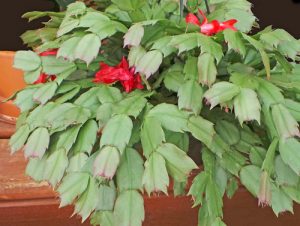
- Soil. Ideally, soil will be humusy, slightly acidic, and well drained. A famous commercial grower in southern California recommends a mix consisting of 40% perlite and 60% peat moss. Keep in mind that peat moss tends to lose its structural integrity after a few years, resulting in poor drainage and suffocation of the roots; periodic repotting into fresh soil resolves this situation.
- Fertilizer. In nature Schlumbergeras receive a constant supply of nutrients from decaying tree foliage, bird droppings, and other natural fertilizer. They normally grow more rapidly than desert-dwelling cacti and therefore can be fertilized more like a conventional houseplant. Use a good-quality, balanced, soluble or granular fertilizer, such as a 10-10-10. If using full strength according to label directions, fertilize monthly. Otherwise, cut the fertilizer rate to about 25% of what is recommended on the label and fertilize with each watering. Stop fertilizing in September to reduce vegetative growth and help stimulate bud formation on strong stems; resume fertilizing after the blossom period. Occasional use of micronutrients may be helpful.
- Pests. Holiday cactus are fairly immune from pests but scale insects, mealybugs, and spider mites can occasionally be problems. Use an approved houseplant insecticide according to label directions. Slugs and snails love holiday cacti, so if growing your plants outdoors, keep the pots off the ground. Holiday cacti have relatively few disease problems but constant moisture in a poorly drained soil will promote the development of root-rotting fungi. If the plants are sagging and not growing even though the soil is moist, you should check to see if it has a healthy root system. If not, take some cuttings to start a new plant and use a better-draining soil mix.
- Propagation. Plants are easily propagated from stem cuttings. Individual “joints” can be used, or cuttings up to 2-3 joints long. Let the cuttings dry in a shady location 2-3 days and then put in a rooting medium such as perlite, or into a good soil mix. Keep the medium moist but not saturated. Rooting should take place in 2-3 weeks and new growth should start. New plants can be started any time of the year, but you may get better results in late spring through summer. After the new plants have started growth, pinch them back to encourage branching. Often, three new plants are potted together to create an instant potful.
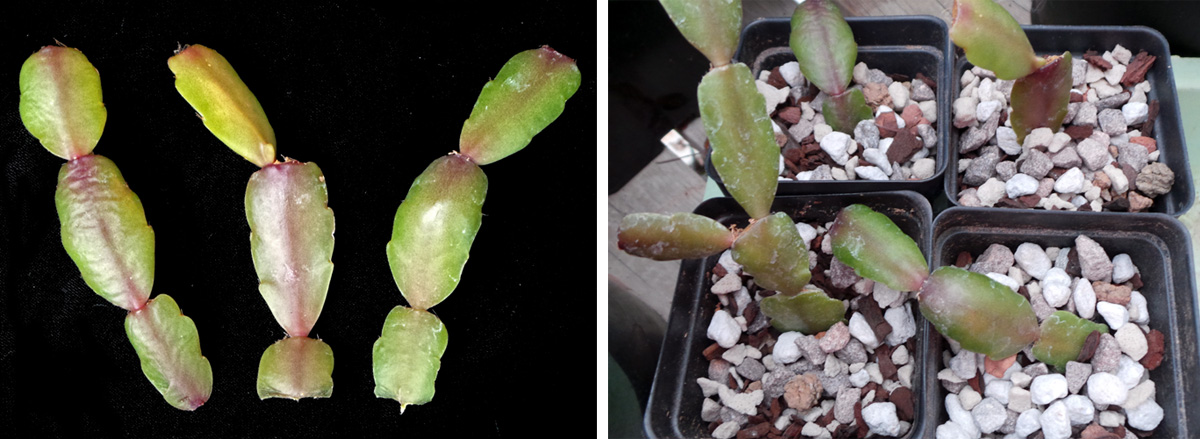
Saving an Old Holiday Cactus – A Special Challenge
A really old, large holiday cactus in full bloom is a beautiful marvel – hundreds of brightly colored flowers can be open at the same time. It is not unusual to see plants in 12-15” diameter pots, with a canopy spread of nearly three feet. These plants can be decades old and literally passed down from generation to generation; such plants may have much sentimental value in addition to their seasonal beauty.
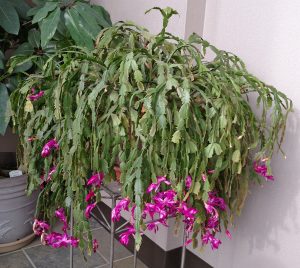
All potted plants need occasional transplanting for various reasons. Most commonly, the plant outgrows the pot. But more cryptically, potting soils become altered through time to no longer be acceptable growing media. As plants get bigger the repotting process becomes more difficult to deal with and avoidance of the inevitable (i.e., procrastination) rears its ugly head. But potting soils can eventually become both chemically toxic and physically lethal to plant roots.
As a succulent plant, the stems of holiday cacti can survive for amazing periods without water if the roots are dead. Entire plant death from slow starvation and dehydration may literally take years. But there are tell-tale signs of stress that include (1) reduced flower bud formation, (2) flower bud abortion, (3) reduced new stem growth, (4) shriveling of the younger stems even when well-watered, (5) “self-pruning” or dropping of younger stem segments, and (6) development of small, hair-like adventitious roots at the bases of many stem segments. Another sign of possible root loss is abnormally prolonged moisture in the soil because of the lack of healthy roots to extract soil moisture during normal transpiration.
As with many maladies, prevention is the best cure. Routinely repot your plant at least every 4-5 years. In the process, be sure to remove most of the old soil and then inspect the roots to be certain they look healthy. Use a well-drained soil mix and cut back on normal watering for a month or so to allow the development of new feeder roots. Large plants may need to be staked until new roots provide firm anchorage.
Another worthwhile practice is to root a few new cuttings every 3-5 years and keep a couple of healthy young plants on hand in case the original plant succumbs.
If you must deal with an obviously-stressed plant, unpot and examine the root system. Cut back any dead or diseased roots and allow the pruned roots to air dry for a few days before repotting. In extreme circumstances, the entire root system may be dead all the way back to the base of the plant; such plants can be very difficult to save. If this is the case, carefully clean the root system as much as possible, maybe just leaving the stem base. Severely prune back the stems so that they are not over-taxing the new roots that hopefully will form. After a few days repot the plant in fresh soil. Water sparingly and just in the area of the surviving roots. If you are successful, the remaining stems will eventually plump up and new stem growth will be apparent. Save numerous cuttings of various sizes and try to root these to produce new plants (see Propagation above). Your success rate may be very low.
Encouraging Blossoming
Have you ever wondered why the plant you received, in full bloom, for Christmas a few years ago has always since bloomed in November? The reason is that the environmental factor that stimulates blossoming is the photoperiod, that is, the amount of hours of daylight. Commercial nurserymen growing holiday cacti artificially control photoperiod by using bright lights to simulate longer days and dark cloth to cover the plants, thereby simulating shorter days. By using the right combination of light and dark, you can stimulate holiday cactus to bloom almost any time of the year. If you really don’t care about the blooming period and are willing to let the plants bloom based on the normal photoperiod, there are just a couple of things to remember.
Cool night temperatures (55-60°F) in combination with the natural Wisconsin photoperiod will successfully induce flowering. If the plants are left in a warm area of the house where temperatures stay above 60°, you will need to regulate the photoperiod. This can be done by covering the plant with black plastic, or moving it in and out of a dark room (such as a closet), so that it receives only about 10 hours of light per day. This needs to be done for about 4 weeks, after which buds will be appearing. Once flower buds start to appear, the plant can be returned to standard room conditions of light and temperature.
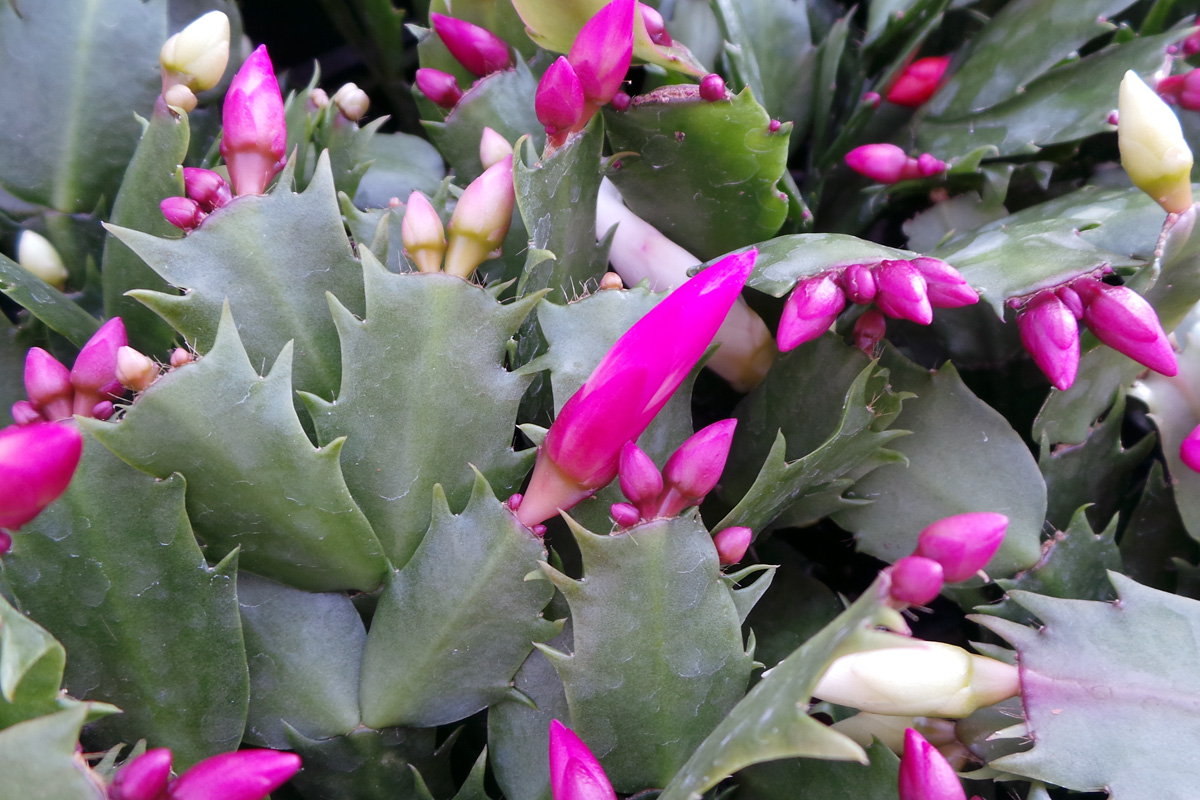
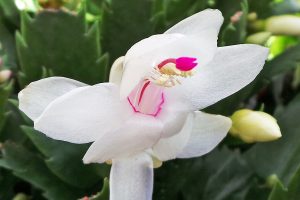
Once buds are starting to form, plants should not be moved into a new location with radically different light or temperature conditions, as many of the buds will stop developing and abort. When in bloom, flowers will last longer if not exposed to high temperatures. Plants should bloom for 2-3 weeks at temperatures around 70°F.
If you want your plants to bloom at a very specific time, such as exactly at Christmas, you can do this by regulating light and temperature as described above. No specific guidelines can be given because each cultivar or hybrid has its own response to specific conditions. Therefore, you may need to experiment for a couple years to determine how to induce your plants to bloom under your growing conditions. Keep in mind that unregulated temperatures may either lengthen or shorten the period from bud initiation to full bloom.
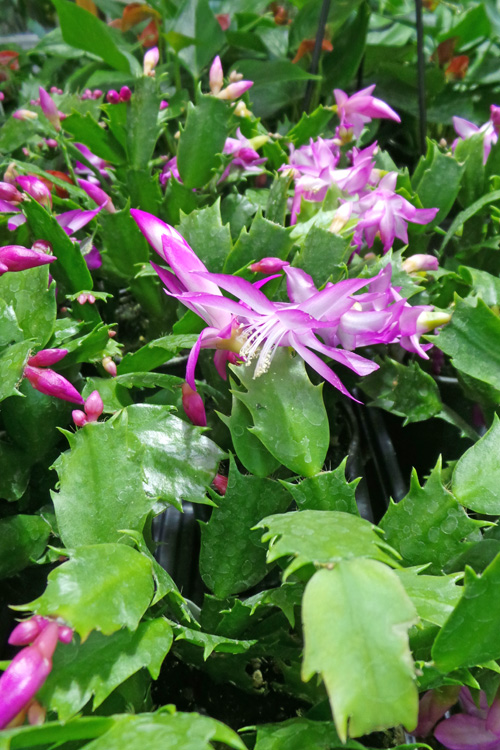
Choosing the right Holiday Cactus
Holiday cactus in a variety of colors are commonly available in garden centers and discount stores starting before Thanksgiving and into the Christmas period. Plants that are in full bloom at Thanksgiving will be done blooming by Christmas. If you want plants that are in bloom at Christmas time, you should look for plants in late November or early December that have well developed buds but no open flowers. Keep in mind that their surrounding temperature will determine how rapidly the buds develop and how long the flowers will last.
In the couple of weeks before Christmas, stores often have plants that are done blooming; these do not sell and often are thrown out right after Christmas. Check with the store manager — you might get a real good price on such plants that should perform very well in the coming year.
Before you buy plants from local outlets, check them carefully to be certain they appear healthy and free of pests such as mites, mealybugs, and scale insects.
– Dan Mahr, University of Wisconsin – Madison





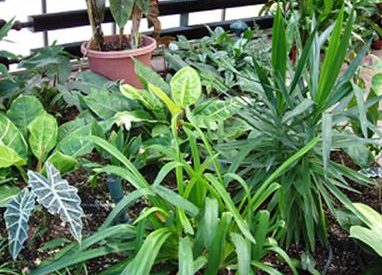 Houseplant Care
Houseplant Care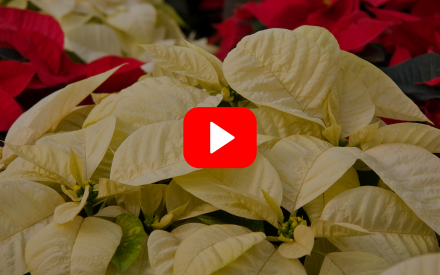 ▶ WATCH: Maintaining Your Festive Houseplants
▶ WATCH: Maintaining Your Festive Houseplants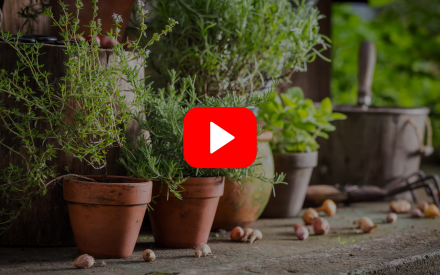 ▶ WATCH: Bringing the Garden Inside
▶ WATCH: Bringing the Garden Inside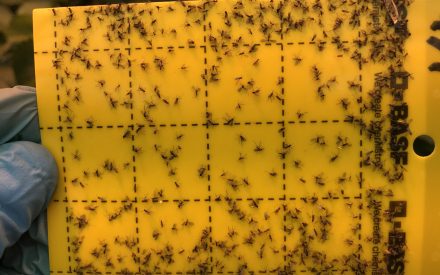 Fungus Gnats on Houseplants
Fungus Gnats on Houseplants


